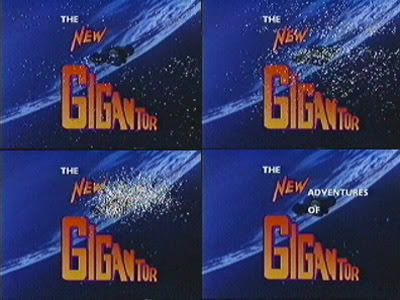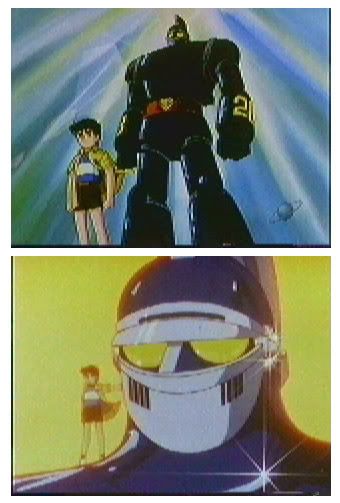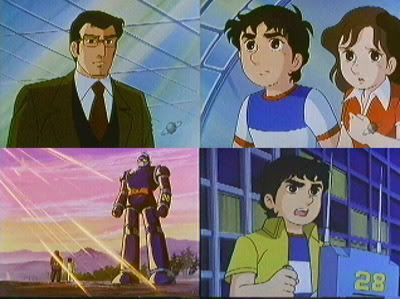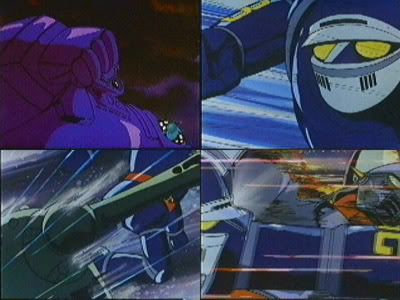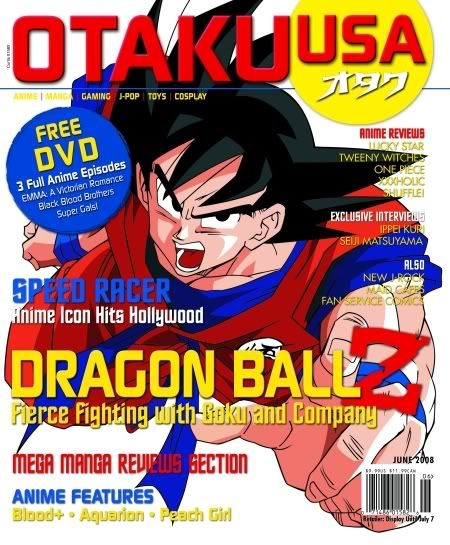
The success of STAR WARS brought many a long-dormant SF franchise out of retirement; even in far away Japan the hunger for space-spanning astro-heroes was acute. If you're going to do STAR WARS, why not bypass Lucas entirely and go right to the source - the pulps?
And so in 1978 Toei Animation Company would give us an anime version of the classic 40s pulp hero CAPTAIN FUTURE . A mysterious hero of the spaceways, Captain Future pilots the mighty spaceship Comet, and, aided by his weird and powerful Futuremen, is pledged to protect Earth and our entire solar system from anything - man, beast, alien, or sentient 4th-dimensional being from beyond time -who threatens peace!
As a science-fictional amalgam of Doc Savage and The Shadow, Captain Future had 17 issues of his own pulp magazine in the 1940s, as well as appearances in other pulps in the early 50s. Created by SF giant Edmond "Starwolf" Hamilton, CAPTAIN FUTURE wouldn't win any literary awards or dazzle impressionable minds with extraordinary prognostications of future trends. What Hamilton's stories did do, however, was entertain. Zippy, two fisted space opera for those who like their heroes with jaws of granite and their villians sneering and malevolent, CAPTAIN FUTURE is unpretentious fun even sixty years later.

(Outer-space fashions of the year 3000!)
But who is CAPTAIN FUTURE? Mortally wounded, a top scientist entrusted his infant son Curtis Newton to the care of three fantastic guardians - an artificially created being with synthetic skin and organs, a seven foot tall super-strong metal robot, and Simon Wright, a genius biologist who cheated death by having his living brain encased in a unbreakable shell equipped with electronic senses and force-beams! Raised to manhood in a secret lunar base and taught all Earthly knowledge by his three protectors, Curtis Newton has devoted all his scientific knowledge to the defeat of evil and the protection of humanity. Together with Planet Police special agents Joan Randall (requisite girlfriend) and Ezra Gurney (grizzled veteran), Captain Future pits his brains and brawn against all foes.

(Grag, the Brain, Otho, and friends; the Comet, Captain Future blasting away)
I'd been aware of the CAPTAIN FUTURE anime series for years; several episodes were dubbed by ZIV Productions and released on home video in the early 1980s. What I didn't realize was how close the Japanese version stuck to the American pulps. I had to track down out-of-print paperback CAPTAIN FUTURE reprints to find out that the "Wrecker" storyline is taken right from the original pulps. Ditto the time-travel story "Lost World Of Time" - straight from Hamilton's overworked typewriter, right to Toei's overworked animation staff.
All of the CAPTAIN FUTURE highlights are present in Toei's show: the friendly rivalry between Grag the robot and Otho the synthetic man; the comic relief of Grag's metal-eating "moon-pup" and Otho's weird meteor-mimic, the persistent outer-space Lois Lane antics of Joan Randall; they're all there, right down to Curt Newton's twin proton pistols, always ready for action. One non-canonical addition to the series was Ken Scott, a (cough cough) kid sidekick.

(Joan Randall, the Earth President, the Moon-Pup)
The cheese factor of the sixty-year old pulps is matched by the cheese factor of the thirty year old animation, which today can't help but look clunky and dated. The work has a lot of the same on-again, off-again character model problems that plagued CAPTAIN HARLOCK, also from Toei around this time, but there's a hand-drawn authenticity to the show that has appeal in today's digital age. The mechanical design is decidely NOT pulpish - what in the 40s was a streamlined, teardrop shaped torpedo of gleaming steel is in 1978 a '2001' style NASA-approved space vehicle with segmented units, auxiliary thrusters, pod bay doors, et cetera - all properly utilitarian, and yet still able to match velocities and penetrate to the electrical universe that exists inside Halley's Comet, or utilize heretofore unheard-of polarities to travel back in time to the birth of the Solar System - and beyond.
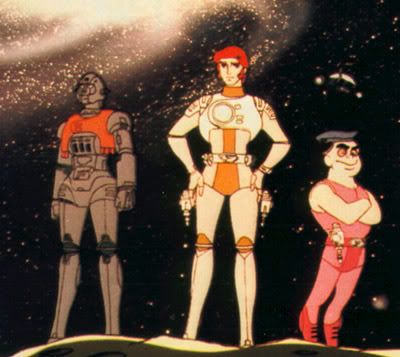
(the Futuremen ready to defend galactic peace!)
CAPTAIN FUTURE ran for 52 episodes, from October of 1978 until November of 1979, and even got a theatrical release of a featurette entitled "Great Solar System Race". Scripts for the series were taken from the 13 original Hamilton pulps. Toei's staff included Tomoharu Katsumata, who would go on to work on My Youth In Arcadia and Saint Seiya. ZIV International, the pioneer of syndicated television, would release two home video CAPTAIN FUTURE adventures - "The Wrecker's Plan" and "Lost World Of Time" - with indifferent dubbing that managed to completely misinterpret the properties of the rare element "gravium", not to mention giving Simon Wright a woman's voice. However, the series would achieve tremendous success in Europe, particularly Germany, where an electronic funk-disco soundtrack by Christan Bruhn would help turn the show into a cult hit. To this day CAPTAIN FUTURE fan clubs operate in Germany.
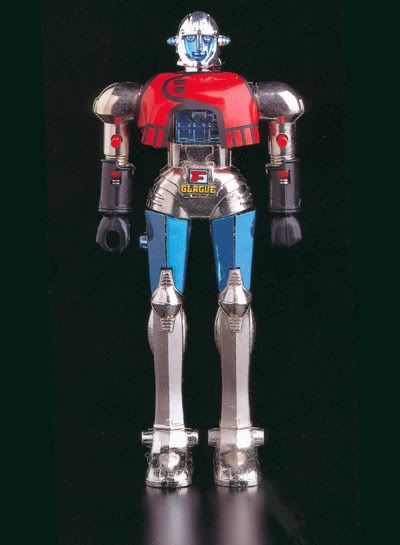
(diecast metal Grag toy with amusingly spelled nameplate)
Japan wasn't done with the Hamilton estate, however; his three part STARWOLF series (which I highly recommend) would become a live-action TV series from Tsuburaya in the late 70s, but wouldn't enjoy the authenticity or the popularity of CAPTAIN FUTURE. It would, however, be immortalized by Mystery Science Theater 3000.
In 1984 Toho would release an ambitious, partially-computer-animated film version of E.E. "Doc" Smith's pulp SF classic LENSMAN, a film that blithely ignored key story elements in favor of stylish visuals, a daring gambit that almost - ALMOST - succeeded.

To this day anime fans sneer at the camp and cheese of pulp SF, while golden age scientifiction enthusiasts turn up their noses at the lurid excesses of 'japanimation'. But there are plenty of us in the mushy middle who enjoy space opera no matter what language it's in. Will CAPTAIN FUTURE and the Futuremen blast out of obscurity again someday? Will the quick draw of a proton pistol once again spell the difference between life and death amidst the booming suns of outer space? Only Curtis Newton and the estate of Edmond Hamilton know for sure!

